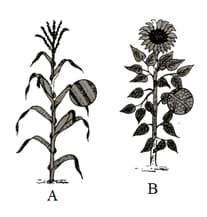Angiosperms
Angiosperms: Overview
This topic describes angiosperms. It explains about its uses, its classes along with their structures. It also describes the life cycle of angiosperms.
Important Questions on Angiosperms
The gametophytic generation in the life cyle of angiosperm is the diploid multicellular phase.
What are two stages in the life cycle of an angiosperm plant?
_____ is the diploid multicellular stage in the life cycle of an angiosperm plant. (Answer in a single word)
The sporophytic generation in the life cycle of angiosperm is a diploid multicellular stage.
What is gametophyte phase in an angiosperm plant.
The _____ develop into a male gametophytic generation which is highly reduced and is confined to only a limited number of cells.
Grafting is not possible in monocots as they ____.
Distinguish between Dicotyledonae and Monocotyledonae.
Angiosperms and shown in the figure belong to the class___________ and ______________respectively

Match column I with column II and select the correct answer:
| Column I | Column II |
| A. Zygote | 1. Haploid |
| B. 4n | 2. Triploid |
| C. Endosperm | 3. 2n |
| D. Synergid | 4. Tetraploid |
Girth of a Maize plant does not increase over a period of time. Justify.
If the diploid number of a flowering plant is 36. What would be the chromosome number in the endosperm?
Which of the following is a set of characteristics corresponding to monocots?
Assertion: More dicot species are known than that of monocot species.
Reason: Two cotyledons are present in the dicot plants.
Assertion: Angiosperms are mostly terrestrial.
Reason: Angiosperms are found in plains only.
Assertion: Angiosperms lack flagellate male gametes.
Reason: Sperms are not dependent on water for fertilization.
